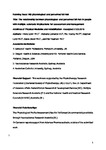The relationship between physiological and perceived fall risk in people with multiple sclerosis: implications for assessment and management
| dc.contributor.author | Gunn, Hilary | |
| dc.contributor.author | Cameron, M | |
| dc.contributor.author | Hoang, P | |
| dc.contributor.author | Lord, S | |
| dc.contributor.author | Shaw, S | |
| dc.contributor.author | Freeman, Jennifer | |
| dc.date.accessioned | 2018-04-23T11:55:05Z | |
| dc.date.issued | 2018-10 | |
| dc.identifier.issn | 0003-9993 | |
| dc.identifier.issn | 1532-821X | |
| dc.identifier.uri | http://hdl.handle.net/10026.1/11325 | |
| dc.description.abstract |
OBJECTIVE: This study evaluated the relationship between physiological and perceived fall risk in people with multiple sclerosis (MS). DESIGN: Secondary analysis of data from prospective cohort studies undertaken in Australia, the United Kingdom, and the United States. SETTING: Community. PARTICIPANTS: Ambulatory people with MS (N=416) (age 51.5±12.0 years; 73% female; 62% relapsing-remitting MS; 13.7±9.9 years disease duration). INTERVENTIONS: Not applicable. MAIN OUTCOME MEASURES: All participants completed measures of physiological (Physiological Profile Assessment [PPA]) and perceived (Falls Efficacy Scale-international [FESi]) fall risk and prospectively recorded falls for 3 months. RESULTS: 155 (37%) of the participants were recurrent fallers (≥2 falls). Mean PPA and FESi scores were high (PPA 2.14±1.87, FESi 34.27±11.18). The PPA and the FESi independently predicted faller classification in logistic regression, which indicated that the odds of being classified as a recurrent faller significantly increased with increasing scores (PPA odds ratio [OR] 1.30 [95% CI 1.17-1.46], FESi OR 1.05 [95% CI 1.03-1.07]). Classification and regression tree analysis divided the sample into four groups based on cutoff values for the PPA: (1) low physiological/low perceived risk (PPA <2.83, FESi <27.5), (2) low physiological/high perceived risk (PPA <2.83, FESi >27.5), (3) high physiological/low perceived risk (PPA >2.83, FESi <35.5), and (4) high physiological/high perceived risk (PPA <2.83, FESi >35.5). Over 50% of participants had a disparity between perceived and physiological fall risk; most were in group 2. It is possible that physiological risk factors not detected by the PPA may also be influential. CONCLUSIONS: This study highlights the importance of considering both physiological and perceived fall risk in MS and the need for further research to explore the complex interrelationships of perceptual and physiological risk factors in this population. This study also supports the importance of developing behavioral and physical interventions that can be tailored to the individual's needs. | |
| dc.format.extent | 2022-2029 | |
| dc.format.medium | Print-Electronic | |
| dc.language | en | |
| dc.language.iso | en | |
| dc.publisher | Elsevier | |
| dc.subject | Accidental falls | |
| dc.subject | Cohort studies | |
| dc.subject | Multiple sclerosis | |
| dc.subject | Rehabilitation | |
| dc.title | The relationship between physiological and perceived fall risk in people with multiple sclerosis: implications for assessment and management | |
| dc.type | journal-article | |
| dc.type | Evaluation Study | |
| dc.type | Journal Article | |
| dc.type | Research Support, Non-U.S. Gov't | |
| dc.type | Research Support, U.S. Gov't, Non-P.H.S. | |
| plymouth.author-url | https://www.webofscience.com/api/gateway?GWVersion=2&SrcApp=PARTNER_APP&SrcAuth=LinksAMR&KeyUT=WOS:000447245600010&DestLinkType=FullRecord&DestApp=ALL_WOS&UsrCustomerID=11bb513d99f797142bcfeffcc58ea008 | |
| plymouth.issue | 10 | |
| plymouth.volume | 99 | |
| plymouth.publication-status | Published | |
| plymouth.journal | Archives of Physical Medicine and Rehabilitation | |
| dc.identifier.doi | 10.1016/j.apmr.2018.03.019 | |
| plymouth.organisational-group | /Plymouth | |
| plymouth.organisational-group | /Plymouth/Faculty of Health | |
| plymouth.organisational-group | /Plymouth/Faculty of Health/School of Health Professions | |
| plymouth.organisational-group | /Plymouth/REF 2021 Researchers by UoA | |
| plymouth.organisational-group | /Plymouth/REF 2021 Researchers by UoA/UoA03 Allied Health Professions, Dentistry, Nursing and Pharmacy | |
| plymouth.organisational-group | /Plymouth/Research Groups | |
| plymouth.organisational-group | /Plymouth/Research Groups/Institute of Health and Community | |
| plymouth.organisational-group | /Plymouth/Research Groups/Plymouth Institute of Health and Care Research (PIHR) | |
| plymouth.organisational-group | /Plymouth/Users by role | |
| plymouth.organisational-group | /Plymouth/Users by role/Academics | |
| plymouth.organisational-group | /Plymouth/Users by role/Researchers in ResearchFish submission | |
| dc.publisher.place | United States | |
| dcterms.dateAccepted | 2018-03-27 | |
| dc.rights.embargodate | 2019-4-24 | |
| dc.identifier.eissn | 1532-821X | |
| dc.rights.embargoperiod | Not known | |
| rioxxterms.versionofrecord | 10.1016/j.apmr.2018.03.019 | |
| rioxxterms.licenseref.uri | http://www.rioxx.net/licenses/all-rights-reserved | |
| rioxxterms.licenseref.startdate | 2018-10 | |
| rioxxterms.type | Journal Article/Review |


